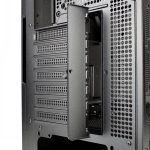With the View 270 TG ARGB, THERMALTAKE is launching a compact “aquarium” case with a glass front and side panel for less than €100, which, despite its modern look, is able to build on the virtues of its older siblings. Read on to find out whether it succeeds and what has to be sacrificed to achieve this.
Even though I don’t like the CTE design with the rotated components and the frequently occurring hotspot problems that Thermaltake has been implementing in more and more cases recently, I do like the general direction in which the quality and features of Thermaltake’s cases are developing, which is very welcome. I was all the more pleased when I finally had a case with a regular orientation on my desk again. Considering that it’s half the price, I can’t compare the View 270 with the recently tested Corsair 6500X, even if it doesn’t look completely out of place at first glance. Let’s unpack the case first to get our own impression of it.
Unboxing
The box comes in the typical Thermaltake design
The case itself looks modern and high-quality at first glance.
Today we’ll start on the other side! How do you open the glass side panel? There are no screws or hinges at the back, just a small notch for levering out the glass panel.
The side panel is hooked in at the bottom and clicked in at the top with solid pins, so there’s no need to worry about it falling off just by looking at it. The glass pane of the View 270 is only 3 mm thick, whereas the front, whose material thickness can be seen from the side, is 4 mm thick.
The front panel is attached in the same way. If you remove it, you have a full view of the spacious main chamber.
The panels under the glass panes can also be removed. Either add-on parts or accessories will come onto the market here in the future, or it is simply for maintenance (cleaning).
Under the case we find a magnetic dust filter for the power supply and two knurled screws for moving the hard disk cage above.
The lid is also equipped with a magnetic dust filter. Up to three 120mm fans or a 360mm radiator (or 2 x 140mm fans or 280mm radiator) can be accommodated underneath. In general, the dust filters and the simple design of the lid and base assembly show that the red pencil has been used here. Even compared to the small Ceres 300, where many parts are made of plastic, you simply get the impression that more “engineering” and “design” has gone into it.
The front I/O, which is mounted on the lid of the View 270 TG, leaves little to be desired.
The rear is nicely airy and offers space for a 140mm fan, which is even pre-installed here in the form of a usable CT 140 ARGB, but is still my biggest criticism of the View 270 TG.
As you may have guessed, the point of criticism is the very simple PCIE slots with break-out slot brackets and the external screw connection.
Not only do the dividers between the individual slots prevent a graphics card from being mounted vertically, this small “flap”, behind which the screws are hidden, also has another disadvantage, which I will describe again in the construction diary.
Otherwise, the interior of the View 270 offers little cause for criticism. Plenty of space and practical cable outlets in the power supply cover make you look forward to installing the components.
However, at first glance, the space available for the only useful radiator installation slot in the lid appears to be quite limited.
At least the centering Nubsi is back at the start:
And this development is also very welcome: More and more manufacturers are converting the connections for the buttons and LEDs to one connection because the board manufacturers have not changed these for some time.
The sheet metal side panel on the right-hand side does not make the most robust impression overall, but at least it is equipped with a magnetic dust filter.
Once it is removed, we have a clear view of the rear.
With over 2.5 cm at the “narrowest” points, we have more than enough space to lay the cables.
Although there are not too many lashing points, the existing ones are strategically cleverly distributed. However, there are no rubber grommets for the cable outlets.
There is plenty of space for the power supply unit:
And the hard disk cage mentioned earlier also has plenty of space.
Another 2.5″ HDD/SSD can be mounted above it.
Apart from the small speaker, there are no “exciting” accessories included in the scope of delivery.





























































18 Antworten
Kommentar
Lade neue Kommentare
Urgestein
Neuling
Veteran
Moderator
Veteran
Neuling
1
Mitglied
Urgestein
Veteran
Urgestein
Neuling
Veteran
Neuling
Mitglied
Veteran
Mitglied
Urgestein
Alle Kommentare lesen unter igor´sLAB Community →